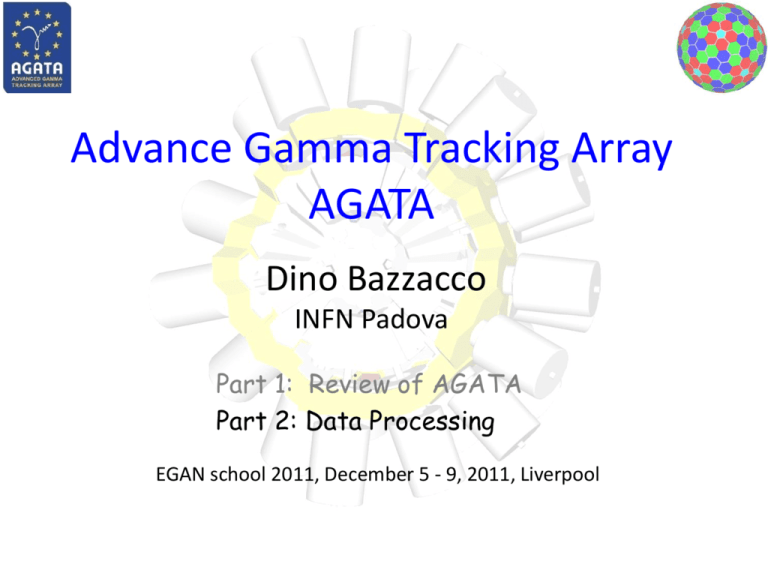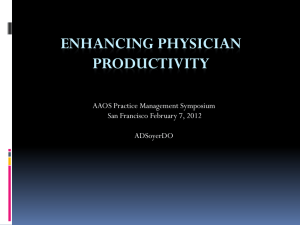5 MB/s
advertisement

Advance Gamma Tracking Array AGATA Dino Bazzacco INFN Padova Part 1: Review of AGATA Part 2: Data Processing EGAN school 2011, December 5 - 9, 2011, Liverpool Architecture of the system • Local Level : where the individual detectors don’t know of each other. – Electronics and computing follow a model with minimum coupling among the individual elements (detectors), which are operated independently as long as possible – Electronics is almost completely digital, operated on the same 100 MHz clock – Data processing (in the electronics and in the front-end computers) is the same for all detectors and proceeds in parallel – Every chunk of data produced is tagged with a time stamp that gives the absolute time (with a precision of 10 ns) since the last startup of the system. (with 48 bits the roll around takes place every 32.5 days) • Global Level : where the detectors do know of each other – By means of the real time trigger, which reduce the data rate by selecting the class of interesting events – Via the event builder and merger that assemble the event fragments (including the ancillaries) into complete events that are further processed – In the tracking and in the Physical analysis stages The fact that 3 (and 2 at GSI) crystals are packed in clusters does not produce any correlation in the data processing (not so for the Detector Support System, but this is not relevant here) Structure of Electronics and DAQ GL Trigger Detector preamp. Digitisers Clock 100 MHz T-Stamp Analogue Up to 180 detectors PreProcessing & PSA Core + 36 seg. Preprocessing Ancillary Ancillary Synchronous Ancillary Event Builder Tracking Control, Storage… Buffered Other detectors 1. interface to GTS via mezzanine 2. merge time-stamped data into event builder (merger) AGATA Data Processing LAN to the disk servers 10 m long MDR cables Computer farm in the computing room 20 m long optical fibers Digital proc. electronics in the users area 80 m long optical fibers Digitisers in the experimental hall One digitizer per crystal: 2 ATCA carriers per crystal: 1 pizza-box per crystal: - core module with 1 core board (clock + 2 cores) 2 segment boards (A B ) -segment module with 4 segment boards (C D E F ) - Master with 1 GTS mezzanine 3 proc. mezzanines (Core A B) - Slave with 4 proc. mezzanines (C D E F) - Readout and save orig. data - Pre-processing of events - PSA 10 pizza-boxes for Event Builder and Merger Ancillary and Tracking 120 TB of storage + Archiving on Grid T1 6 channels processing mezzanine Data rates in AGATA Demonstrator 50 kHz singles 1 kHz triggered SEGMENT + - ADC Pre-processing 100 Ms/s 200 MB/s 14 bits 7.6 GB/s GL-Trigger Energy +··· ~ 200 B/channel ~ 2 kB/s/channel LL-Trigger (CC) DETECTOR ~1 ms/event 36+2 9296 B/event Compression factor ~2 10 MB/s 5 MB/s/det. raw data to disk GLOBAL save 1 ms of pulse rise time Pulse Shape Analysis + ~1 MB/s from ancillary detectors, when used 15*0.2 3 MB/s Event Builder g-ray Tracking E, t, x, y, z,... 200 B/event 0.2 MB/s/det. < 5 MB/s HL-Trigger, Storage On Line Analysis 180*0.2 36 MB/s (Full AGATA) 40 MB/s Saving the original data produces ~5 ÷ 30 TB / experiment GL-Trigger to reduce to whatever value be able Our disk server (100event TB) israte always almost full PSA datawill archived to to themanage GRID GTS : the system coordinator All detectors operated on the same 100 MHz clock Downwards Upwards Downwards 100 MHz clock + 48 bit Timestamp (updated every 16 clock cycles) trigger requests, consisting of address (8 bit) and timestamp (16 bit) max request rate 10 MHz total, 1 MHz/detector validations/rejections, consisting or request + event number (24 bit) M.Bellato , Agata Week Darmstadt - 6-9 September 2011 1:15 GTS Tree + 1 VME subsystem GTS Tree with the Fully Digital Trigger Processor GTS tree to: - Distribute the 100 MHz clock - Collect the trigger requests (i.e. 16-bit time stamp and address of the requesting node) - Return validations or rejections messages to the requesting node Max 1 MHz trigger requests/node Built out of GTS mezzanines - Runs on an evaluation board with a VIRTEX5 FPGA - Partitions and sum buses implemented in VHDL - 2nd level logic is implemented in C and runs in the PPC - Uses idle-messages to timeout non-participating nodes - Present version has 48 inputs and 4 partitions - Each partition has 4 multiplicity thresholds The “3 to 1” structure can be - The two partitions can be operated in coincidence extended up to 3 levels P1 with the Ge crystals Trig1 P1 >=1 & P2 = 1 9 triple clusters or P2 with the ancillary Trig2 P1 >=2 8 triple clusters + 3 ancillaries Marco Bellato, Luciano Berti, Joël Chavas Handles max 100 kHz of coincidences (limited by PPC) Available Triggers • multiplicity – up to 4 partitions(P), each one with 4 multiplicity thresholds – often used with 1 partition containing the 15 Ge detectors – digital version of the classical multiplicity sum bus • ancillary – P1(Ge) AND P2(Ancillary) coincidence condition is a window on the timestamps • ancillary2 – (P1 AND P2) OR (P2 AND NOT P1) (e.g. validate PRISMA even if there is no gamma coincidence) • Service triggers – validate_all – reject_all Preamplifiers (Bart) Digitizers • 100 MS/s – max frequency correctly handled is 50 MHz (Nyquist) • 14 bits – Effective number of bits is ~12.5 (SNR ~75 db) • • • • 2 cores and 36 segments (in 6 boards) Core 2 ranges 5, 20 MeV nominal Segments either high or low gain The digitized samples are serialized and transmitted via optical fibre (1/channel) to the preprocessing electronics. Transmission rate is 2 Gbit/s on each of the 38 fibres. • Power consumption 240 W • Weight 35 kg Beware of aliasing! Sampling theorem: analogue input signals limited to a bandwidth fBW can be reproduced from their samples with no loss of information if they sampled at a frequency fs ≥ 2fBW Nyquist frequency At 100 Ms/s, the preamplifier signals must be filtered, at the input of the, the digitizer to remove frequencies above 50 MHz (in practice above ~20 MHz) AGATA Digitisers As the digitizers just digitize and transmit the sample, they operate very smoothly, need to be power-cycled very rarely, which is good for the gain stability of the signals. Range of digitizers 1 5B 3B 2B 4B 1B 5G 3G 2G 4G 1G 5R 3R 2R 4R 1R Some cores and segments saturate below 3 MeV on the high-gain range Gain in the digitizers should be reduced by ~30% test5atc_110603/run_000 Range of Digitizers Values derived from the energy calibration coefficients , with offsets adjusted to have the “zero”of preamp signals at ¼ of the conversion range Range of digitizers 2 Operation at high counting rates 1R CC high gain 1R CC low gain 1R B1 (low gain) CC ~30 kHz segment B1 ~7 kHz 1 ms Preprocessing Electronics • Fully digital, processing 38 channels in parallel for each crystal. • Receives the continuous stream of samples from the digitizers. • Generates the energy by means of a trapezoidal shaper • Generates the local trigger on the core (CC) signal by Leading Edge Discriminator (or CFD) • Takes a snap shot of 1 ms (100 samples) on all 38 channels • Sends validated events to the front-end computers • For 1 crystals: 2 ATCA carrier boards, 7 processing mezzanines and 1 GTS node. 6 crystals in one ATCA crate (228 high resolution channels) Signal Processing in the electronics – Noise and disturbances in the signals – Effective band width of the signals – Deconvolution of the main pole – Deconvolution of 2nd order effects in detector/preamp chain (multiple poles) – Triangular (trapezoidal) shaping – Adaptive shaping for high counting rates – More sophisticated BLR – Treatment of saturated signals by ToT –… Convolution and Correlation Signal processing blocks can be often described as linear (and time invariant) systems that act on an the input to produce an output. h[n] is the transfer function of the system • Convolution: how a linear system acts on the input to produce the output N 1 N 1 i 0 i 0 y[n] x[n] h[n] x[i ]h[n i ] x[n i ]h[i ] • Correlation: evidences similarity of two signals N 1 N 1 i 0 i 0 Rxy [n] x[n] y[n] x[i ] y[i n] x[i n] y[i ] • Autocorrelation: short and long term correlations in a signal N 1 Rxx [n] x[n] x[n] x[i ]x[i n] i 0 Transforms • Mapping of one space to another (dual) in order to simplify and/or speedup operations that are difficult and/or slow in the original one space. • Fourier Transform time ↔ frequency – Analysis of noise, detector response function, action of filters and shapers • Laplace Transform time ↔ s – Solving differential equations • Z Transform sample number ↔ z – Solving difference equations and expressing in an analytical way filters and shapers • Common and useful properties – – – – Linearity Derivation Integration Convolution T(a·f(t) + b·g(t)) D(f(t)) I(f(t)) T(f(t)g(t)) = a·T(f(t)) + b·T(g(t)) = s·T(f(t)) + initial condition = T(f(t))/s = T(f(t)) ·T(g(t)) • In general the original and transformed variables are complex . In Signal Processing the original data is almost always real and the transformed variable is often also real (e.g. power spectra with all phases set to zero so that only the amplitude is of interest) Fourier Transform(s) The Scientist and Engineer's Guide to Digital Signal Processing By Steven W. Smith www.dspguide.com/index.htm Discrete Fourier Transform of real signals dspguide N 1 X [k ] x[n] e i 2 k n N Forward decomposition n 0 1 x[n] N N 1 X [k ] e i 2 k n N Inverse synthesis k 0 N real signals mapped to N coefficients ( N+2, but 2 are identically zero: sin[0], sin[N/2]) Vector representation (cos,sin) useful for calculations Polar representation (magnitude, phase) used for human inspection For large N, calculated using the Fast Fourier Transfor (FFT) algorithm Useful theorems • Parseval: correspondence between time and frequency power spectra 2 N 1 x n 0 1 σ N 1 N X 1 σ2 N n 0 2 N 1 2 N 1 Xn 0 2 INP N 2 N 1 x 0 n 1 2 N 2 N 1 X FWHM σ 8 ln 2 n 0 3.33 INP N S|xn|2 / N corresponds to the variance s2 if the “noise” spectra have <xn>=0 The integrated noise power of the DFT spectra is multiplied by 2 because we use only positive frequencies up to Nyquist (unilateral representations). • Wiener-Kintchine: the autocorrelation function of a signal is the Inverse Fourier Transform of its the power spectral density N 1 Rxx [d ] x[n] x[n d ] F 1 ( F ( x) F ( x)) n 0 Noise spectrum from “empty” sampled signals Sampled signals of “noise” Averaged noise amplitude unsing only “empty” traces 100000 samples * 10 ns 1 ms frequency resolution 1 kHz Amplitude (kev/√Hz) Noise spectra of ATC1 (2010-03-18 after improving grounding) Frequency kHz Autocorrelation of noise • Autocorrelation determined from the inverse of the noise density power spectrum, obtained by averaging “empty” traces • Autocorrelation enhances the evidence of periodic disturbances • Allows to determine the high frequency cut of the total preamplifier+digitizer transfer function Repetitive disturbances Gaussian bursts Repetition 50 kHz High frequency 8 MHz High frequency cut of spectrum Autocorrelation rotated to the centre; normalized to the maximum for the 4 channels CC A4,A5 A1 t = 16 ns t = 30-35 ns as most of the other segments t = 14 ns as A2 and A3 (preamplifier board not slowed down) “Deconvolution” of Ge signals • Signals from Ge preamplifiers are, ideally, exponentials with only one decay constant R CF vi(t) ii(t)=Q·δ(t) CI=CS+CP+CA A In practice the output exponential is produced in stages : - RCF charge loop with decay constant t0~1 ms vo(t) - CR differentiation to reduce the decay constant to t1 ~50 ms - P/Z cancellation to remove the undershoot and the long recovery (with tt0) due to the differentiation of the first exponential. • Task of the deconvolution is to remove the exponential to recover the original dt at the input of the preamplifier • Trapezoidal shaping is then just an integration followed by delayed subtraction followed by a moving average • In practice Trapezoidal shaping is the optimum shaping if the noise is white and the collection time (width of the “delta”) varies a lot as in the large volume semi-coax Ge AGATA detectors Essentials of the z-transform • Development of shapers done using the z-transform formalism. • The most useful result is: if in the z domain the system function can be expressed as ratio of polynomials, in the time domain it is possible to realize it as a FIR or an IIR recursive filter with coefficients given by the coefficients of the polynomials. • We proceed in an informal way, assuming that the ROC exists and corresponds to one-sided casual signals • The relevant z-transform features are: delta function δ[n] step function u[n] k - units delay operator z k decaying exponentia l deconvolut ion of exp. integratio n 1 1 1 - z -1 y n x n -k n τ 1 1 τ e (a e ) -1 1 - az D(τ( 1 - a z -1 ( D e δ ) - I(τ( 1 1 - z -1 z-domain ( Iδ u ) y n x n a y n -1 y n x n a x n -1 y n x n y n -1 time domain Synthesis of Trapezoid by a cascade of filters 1 1 a z -1 Exponentia l input signal X1 Deconvolut ion of exponentia l X 2 X1 (1 a z -1 ) Integrate to get a step 1 1 a z -1 X3 X 2 X1 1 z -1 1 z -1 Delayed step (K M) X 4 X 3 z (K M) Subtract delayed step X 5 X 3 - X 4 X1 Integrate X6 X5 Delay by K X 7 X 6 z K X8 Subtract and normalize Transfer function H(z) Moving sum 1 az (1 z (K M) ) -1 1 z -1 1 1 z -1 K (K M) X6 - X7 1 z 1 az 1 z X5 X1 -1 K 1 z 1 z -1 1 z -1 -1 1 z K 1 a z -1 1 z (K M) 1 z K K 1 z -1 1 z -1 Other formulations and implementations A.Georgiev and W. Gast, IEEE Trans. Nucl. Sci., 40(1993)770 “Moving Window Deconvolution” V.T.Jordanov and G.F.Knoll, Nucl.Instr.Meth., A353(1994)261 M Moving average Deconvolution and shaping: ideal exponential Flat top M=100 Any point of the flat-top is a good measure of the energy Risetime K=1000 2011_week23 (R.Chapman, F.Haas) Segment A6 ~3 kHz Shaping 2.5-1-2.5 ms Core (low gain) ~40 kHz Shaping 2.5-1-2.5 ms Base line not at zero and fluctuating. Need to use the Base Line Restorer (BLR), a time variant filter that averages the baseline when the trapezoid is below a given amplitude. Signal Amplitude = Value at flat-top – value of baseline Base-line stabilisation continuous (exponential) average of baseline automatic detection of pulses based on variance feed-back to deconvolution stage to bring baseline down to zero Upper part without feedback (as used at present) Lower part with feedback (used in the next electronics) Adjustment of decay constant is critical for a good flat top 7700 Energy readout towards the end of flat top Readout time fixed by the trigger on CC t = 43.6 ms t = 46.4 ms 7600 Effect of shaping on noise Exponential with t=4600 samples Trapezoidal shaping 1900-100-1900 Total width 3900 Trapezoid 1000-1000-1000 + averaging 900 Flat top 100 Total width 3900 Amplitude keV/√(kHz) Fourier spectrum of noise for S001 CC frequency (kHz) Amplitude Noise spectrum from DFT-1 FWHM = 4.87*2.355 = 11.48 keV Sample number Time domain convolution with the 2 transfer functions Quasi triangular Trapezoidal + average FWHM (quasi-triangular) = 0.559*2.355 = 1.32 keV FWHM (trap. + average) = 0.612*2.355 = 1.44 keV Frequency domain multiplication with the 2 transfer functions Original Shaped by quasi-triangular Shaped by trap. + average Noise component of energy resolution from Integrated Power Spectra Original Shaped by quasi-triangular Shaped by trap. + average 1.19E11 1.87E9 1.56E9 Original Quasi-Tr. Trapz.+Av FWHM = 3.33 √( 1.19 1011) /105 = 11.49 keV FWHM = 3.33 √( 1.56 1011) /105 = 1.32 keV FWHM = 3.33 √( 1.87 1011) /105 = 1.45 keV Noise performance of shapers Core and Segment C3 2.2 Segment C3 Triang 2.0 Core-P1 Triang. FWHM (keV) 1.8 Core-P1 Trap. + Aver. 1.6 1.4 1.2 1.0 0.8 0.6 0.4 0 20 40 60 80 100 Total time (microseconds) In the limit of very low counting rate and perfect BLR, the best resolution would be : C3: 0.675 keV at [39-1-39] (Pt=40 Tt=78) Triangular with 1 ms flat top CC: 1.269 keV at [14-1-14] (Pt=15 Tt=29) Triangular with 1 ms flat top CC: 1.406 keV at [7-7-6] (Pt=14 Tt=27) Trapezoidal + Average with 1 ms flat top Singles rates and shaping time 6 different rates x 4 trapezoid risetimes x 6 BLR lengths 60Co 137Cs - fixed – 6 positions Two independent sources of dead-time: pile-up rejector and GTS F.Recchia Structure of Data Processing • Local level processing – AGATA Front end electronics • Readout • Pre-processing • PSA – Ancillaries VME+AGAVA FEE FEE RO RO FEE RO RO PP PP GTS PP PP • Readout • Pre-processing • Global Level processing – – – – – Event builder Event merger Pre-processing Tracking Post-Processing Ch. Theisen DAQ Farm 1 U pizza-box server 2 4-core CPUs 16 GByte memory 11 IBM pizza-box servers (+ 1 pizza/crystal) 1 Host gateway 1 KVM, 2 Switches, … 60 (+60) TB storage 15 TB for local backups Permanent storage and data distribution exploring GRID-approach via CNAF Ancillary 1R 1G 1B …. Digitizer or raw data file VME or raw data file CrystalProducer EventBuilder AncillaryProducer PreprocessingFilter EventMerger AncillaryFilter PSAFilter TrackingFilter Consumer Save PSA output Consumer Save tracked output Narval Topology for 5 ATC + Ancillary Data processing and replay • Online = Offline • A series of programs organized in the style of Narval actors • Director of the actors – Online : Narval – Offline : Narval or narval emulator(s) • Depending on the available computing resources • Single computer • Farm with distributed processing • The system is complex and “difficult” to manage – – – – – Very large number of detectors NumberOfCrystals*38 5 ATC = 555 No chance to take care of them individually Rely on automatic procedures Hope that the system is stable Result depends on average performance Several “problematic” segments Problems fixed Data processing and replay • Online = Offline • • A series of programs organized in the style of Narval actors Director of the actors – Online : Narval – Offline : Narval or narval emulator(s) • • • • Depending on the available computing resources Single computer Farm with distributed processing The system is complex and “difficult” to manage – – – – – Very large number of detectors NumberOfCrystals*38 5 ATC = 555 No chance to take care of them individually Rely on automatic procedures Hope that the system is stable Result depends on average performance • Need GUIs, Histogram Viewers and and scripts to manage the work • Processing/Analysis model developed with contributions of several people – Xavier Grave Olivier Stezowski and their groups for the architecture and the basic tools – Joa Ljungvall, Daniele Mengoni, Enrico Calore, Francesco Recchia – The users and their feedback Structure of analysis directories • The directory where you produce your data ( e.g. /agatadisks/data/2011_week41/zCurrentNarvalDataDir) contain some standard sub-directories – Conf contains configuration of actors, calibrations, ... for each detector 1R 1G 1B 2R ... 5B Ancillary Global with minimal differences between online and offline – Data contains the data produced during the experiment 1R 1G 1B 2R ... 5B Ancillary Global Online writes data here Offline takes data from here – Out where we write the offline data 1R 1G 1B 2R ... 5B Ancillary Global Offline writes data here Conf, Data and Out are often symbolic links to actual directories The actors • Producers – CrystalProducer / CrystalProducerATCA – AncillaryProducerTCP – BasicAFP • Filters – PreprocessingFilter / PreprocessingFilterPSA – PSAFilter / PSAFilterGridSearch – TrackingFilter / TrackingFilterOFT • Consumers – BasicAFC • Builders – EventBuilder/EventMerger • ADA version for the online • C++ version in the femul emulator CrystalProducer • Reads the data from: – The PCI express driver connected to the ATCA electronics – Raw data files (event_mezzdata.bdat) for the offline • Acts as a local event builder to check and merge the sub-events coming from the ATCA readout (or from the raw data file) – – – – For the online has to work in nonblocking-mode to avoid blocking the ACQ This feature was implemented with boost::threads Damiano has now implemented the “select” and threads have been removed The local event builder and the management of the mezzanine data should be completely rewritten … • Can write the original data with the format of the ATCA electronics, and various other formats (e.g. only the energies for calibrations) • Prepares data:crystal frames, without using adf (version using adf exists, maybe slower) PreprocesssingFilter • Performs – Energy calibrations and xTalk corrections – Analysis of traces • • • • Calculation of T0 from core (Digital CFD or linear fit of the first samples) Time calibrations and shifts Vertical normalization of traces Define the net-charge segments – Reformats the data as data:ccrystal frames • The calibration files are produced by external programs as part of the calibration procedures; these programs work on more compact data files written by the CrystalProducer. PSAFilter • Signal decomposition • Implemented algorithm is the Grid Search – As a full grid search – As a coarse/fine search (AGS) • Reduces size of data by factor 20 • Provides the parameters for the correction of neutron damage (can also perform it) • Must be expanded to improve timing • Takes ~95 % of total CPU time • Is the critical point for the processing speed of online and offline analyses AncillaryProducerTCP • Written as a tcp server • Is not an ADF::NarvalProducer (but, for the sake of the emulators can inherit from it) • Reads data via tcp • Decodes the AGAVA structure and VME data • Formats the data as data:ranc0, not using adf • Can write the input data as raw binary files event_vmedata.bdat AncillaryFilter • Analysis of Ancillary data • Changes a lot from experiment to experiment – – – – PRISMA Dante Silicon strip detectors Scintillators • Almost impossible to set int up properly during the experiment • In the last experiments, people gave up trying to analyse them on-line and usually opt for root-like methods • What remains is simply raw or calibrated projections of VME data EventBuilder/EventMerger • Work on data filtered by the real-time digital trigger • The software builders use the timestamp of the data coming from the detectors – Could also reconstruct using the eventnumber but this is given with only 24 bits and rolls over every 16M events modulo electronics • The online Narval builders had a hard life in keeping up with the variability of data flow and sometimes lost synchronization. – A solution was to have very large timeouts in the reconstruction algorithms but this slowed too much down the stop procedures – The latest improvements by Xavier Grave have not yet been tested • The offline builders have a simpler life because data flow from files is (?) more smooth (and the timeouts in the reconstruction algorithms can be very large) TrackingFilter • This is the first point where we can check integrity of global events and analyse them – As AGATA only • Build global spectra: energy, time and Tgg • Adjust gain of CC (and SG, not implemented) should be moved to postPSA • Force sum energy of segments to energy of CC small loss of resolution but removes extra left tail – As AGATA + Ancillary • Spectra of Ge in coincidence with ancillary • Gate on TGe-Tanc (still timestamp only) to select the data for tracking • Input of tracking can be written in mgt-style for offline tracking with OFT or MGT • Tacking algorihm – – – – TrackingFilterOFT Waely’s, parameter-free cluster tracking algo Has been a bottleneck, but now can achieve 20 kHz Problem: Timing not reported well • Output of Tracking written as adf or root tree – Both outputs keep the input hits (and the Ancillary data if present), adding the tracked gammas and the Ancillary filter – Timing is not yet reported properly For the workshop? • Energy calibrations • Cross talk calibrations and corrections • Time calibrations Details on the configuration files • The Conf directories contain, for each used actor, one file with “keyword value” pairs to control the details of the actual analysis. • The name of the configuration file is always actorName.conf • If the actor is organized as a mother-class/daughter-class the daughter can also have its configuration files (e.g for energy calibrations, xTalk corrections, description of ATCA and VME hardware ...), but these are specific and, unfortunately, the names are not standardized • The configuration files for the crystals are very similar; the changes to adapt them to the specific experiment/analysis have been done often using tools like sed error prone • Clearly, we need some graphics interface • As a temporary solution there is now a python script “gen_conf.py” which simplifies the job • For energy calibrations, xTalks, n-damage, ..., there are (or there should be) dedicated programs which should produce and copy to the target directories the proper files • The Narval API puts constraints on how some of the parameters are passed to the system The Grid Search algorithm implemented in Narval as PSAFilterGridSearch • • • • • • • Signal decomposition assumes one interaction per segment The decomposition uses the transients and a differentiated version of the net charge pulse Proportional and differential cross-talk are included using the xTalk coefficients of the preprocessing. The minimum energy of the “hit” segments is a parameter in the PreprocessingFilter 10 keV No limit to the number of fired segments (i.e. up to 36) The number of used neighbours is a compile time parameter (usually 2 as Manhattan distance) The algorithm cycles through the segments in order of decreasing energy; the result of the decomposition is removed from the remaining signal subtraction method at detector level • Presently using ADL bases (Bart Bruyneel) with the neutron-damage correction model (the n-damage correction is not yet fully implemented in this actor) • • Using 2 mm grids ~48000 grid points in a crystal; 700-2000 points/segments Speed is 150 events/s/core for the Full Grid Search 1000 events/s/core for the Adaptive Grid Search To speedup execution, parallelism has been implemented (using boost:threads) with blocks of ~100 events passed to N parallel threads of execution • Speed does not increase linearly with the number of threads Amdahl’s law T = Tserial + Tparallel/Nthreads 5000 Expected from profiler results for 1 thread 10 % serial 90 % parallel 4500 4000 Events/s 3500 3000 30 % serial 70% parallel 2500 Actual speed of Adaptive Grid Search 2000 1500 1000 500 0 0 5 10 15 20 Number of threads 25






